We collect the rainwater from the surrounding rooftops to foresee in the water supply of the rooftopgarden. As the rooftopgarden has a limited amount of soil, and because the elements (wind and sun) are stronger high on the rooftops, the soil needs more water than in a ‘natural’ situation. The watermanagement becomes thus very important. It takes up to two hours to water the complete garden manually, with the hose. To save time, we decide to install an automatic wateringsystem, consisting of a microdrip system that is connected to the watertanks and that is controlled by humidity sensors.
To develop and automate the wateringsystem in the rooftop garden, we plan a workshop with Jonas Z. to look into the possibilities of his OSMOGAS concept in real physical situations. OSMOGAS (open source modular gardening systems) researches easy deployable modular systems for gardens. It consists of three main groups of modules. The first group are evironmental measurement sensors (air pollution, humidity, temperature, UV, wind, pH, …), the second group focuses on the ‘outputs’ (digitally controlled switches for water pumps, lights, fog-generators, …) and the third group develops stand-alone systems or the connections to bigger systems (computers, servers). The project focuses on simplicity, DIY and user friendlyness while designing and producing the modules. All code is available online, as well as the schemes and drawings for DIY, and manuals are edited in an understandable language.
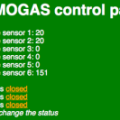
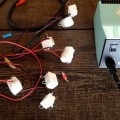
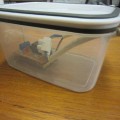
Osmogas automatic watering system: parts. Relay box – controlled via Arduino or compatible board, can handle 2200W. osmogas and osmogas rooftop garden.
Measuring moisture can be done very cheaply and easily if done with care. The principle is based on the water conductivity in soil – the more water in soil (more moisture), the more conductive it gets. We measure the conductivity by simply trying to push current trough the soil and measuring how much get trough. This is done by pair of wires or nails at circa 2 cm distance. To connect such sensors, we work as with other resistance based sensors – to one pin we provide 5V and from other pin we get the output. It is required to use a pull down resistor as well. This means, we connect a smaller resistor from the output of the sensor to the ground.
Sunlight, temperature, water drainage and fertilizer control: another garden automation system is called GardenBot. It uses open source hardware (Arduino) to monitor humidity, temperature and soil conditions. The key modules for the system are soil moisture sensor, soil temperature sensor, light level and water value. Each of these modules can be built separately and integrated into GardenBot. Once GardenBot is alive, it can send data to a computer so that the information is plotted on a chart and updated every 15 minutes. gardenbot
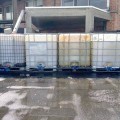


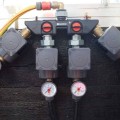
8 x 1000 liter + 4 x 250 liter wateropslag (van het aanpalende dak en recuperatie van het serredak) wordt opgeslagen in de klassieke witte recuperatie watertonnen. Doordat de tonnen wit en semi-transparant zijn, ontstaat er algengroei. Iemand raadde mij aan om een UV filter te plaatsen. Is dit de oplossing? Blijkbaar niet, vwant het water moet dan continu door de filter heenstromen, anders komt de algengroei weer. Eventueel de tonnen zwart verven, of inpakken met opaque plastic. Een filter plaatsen nadat het water door de pomp gegaan is.
Ik heb de tonnen na enkele maanden ingepakt met anti-worteldoek zodat ze afgeschermd zijn van het licht ter voorkoming van draadalgen vorming. Grote filter geplaatst na kraan na pomp (01/10/2012). Toevoer aangebracht in de serre. Vandaaruit 4 circuits gelegd, met op elk circuit nog eens een extra filter en druk(bar)controle: 1 voor de serre en 3 buiten. Microdrip systeem verder uitgewerkt met oranje (2 l/uur) en zwarte (4 l/uur) nozzles.
Green roofs water management : the virtues of moss
A moss garden is a micro ecology. It tells a lot about the bigger ecological system it is part of. It acts in a way as a bio indicator. Moss is very resilient. How expansible is this resilience in city context?
Moss is also a source of inspiration for designing new materials. Bio mimicry. More info on moss in the rroftop garden: moss garden, Tortula muralis and Tortula muralis research.
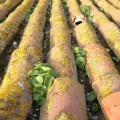
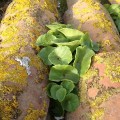
moss on the roofs of the valldaura project
While green roofing is an accepted stormwater control technology, little is known about the quality of the roof runoff. In Phase I of this research, several green roof media (formed from commonly-used expanded minerals, stormwater filter media, and organic matter) were evaluated for their abilities to retain the pollutants from a synthetic acid rain. The samples were analyzed for metals, nutrients, and pH. The hypothesis was that a mixed media that is “better” at pollutant removal and permanent retention could be created based on these laboratory testing results. A media composed of expanded shale, granular activated carbon, and sphagnum peat moss was the most effective.
